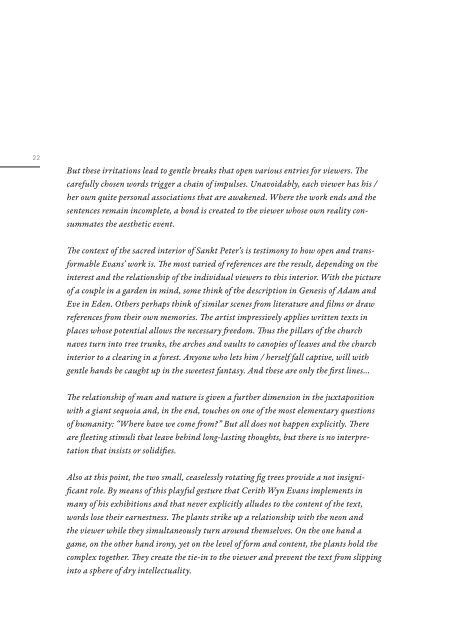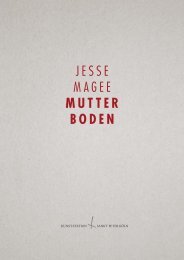Cerith Wyn Evans „...later on they are in a garden...“
Katalog zur Ausstellung in der Kunst-Station Sankt Peter Köln 4. Mai - 14. Juli 2013
Katalog zur Ausstellung in der Kunst-Station Sankt Peter Köln
4. Mai - 14. Juli 2013
Sie wollen auch ein ePaper? Erhöhen Sie die Reichweite Ihrer Titel.
YUMPU macht aus Druck-PDFs automatisch weboptimierte ePaper, die Google liebt.
22<br />
But these irritati<strong>on</strong>s lead to gentle breaks that open various entries for viewers. The<br />
c<strong>are</strong>fully chosen words trigger a cha<strong>in</strong> of impulses. Unavoidably, each viewer has his /<br />
her own quite pers<strong>on</strong>al associati<strong>on</strong>s that <strong>are</strong> awakened. Where the work ends and the<br />
sentences rema<strong>in</strong> <strong>in</strong>complete, a b<strong>on</strong>d is created to the viewer whose own reality c<strong>on</strong>summates<br />
the aesthetic event.<br />
The c<strong>on</strong>text of the sacred <strong>in</strong>terior of Sankt Peter’s is testim<strong>on</strong>y to how open and transformable<br />
<str<strong>on</strong>g>Evans</str<strong>on</strong>g>’ work is. The most varied of references <strong>are</strong> the result, depend<strong>in</strong>g <strong>on</strong> the<br />
<strong>in</strong>terest and the relati<strong>on</strong>ship of the <strong>in</strong>dividual viewers to this <strong>in</strong>terior. With the picture<br />
of a couple <strong>in</strong> a <strong>garden</strong> <strong>in</strong> m<strong>in</strong>d, some th<strong>in</strong>k of the descripti<strong>on</strong> <strong>in</strong> Genesis of Adam and<br />
Eve <strong>in</strong> Eden. Others perhaps th<strong>in</strong>k of similar scenes from literature and films or draw<br />
references from their own memories. The artist impressively applies written texts <strong>in</strong><br />
places whose potential allows the necessary freedom. Thus the pillars of the church<br />
naves turn <strong>in</strong>to tree trunks, the arches and vaults to canopies of leaves and the church<br />
<strong>in</strong>terior to a clear<strong>in</strong>g <strong>in</strong> a forest. Any<strong>on</strong>e who lets him / herself fall captive, will with<br />
gentle hands be caught up <strong>in</strong> the sweetest fantasy. And these <strong>are</strong> <strong>on</strong>ly the first l<strong>in</strong>es…<br />
The relati<strong>on</strong>ship of man and nature is given a further dimensi<strong>on</strong> <strong>in</strong> the juxtapositi<strong>on</strong><br />
with a giant sequoia and, <strong>in</strong> the end, touches <strong>on</strong> <strong>on</strong>e of the most elementary questi<strong>on</strong>s<br />
of humanity: <strong>“</strong>Where have we come from?” But all does not happen explicitly. There<br />
<strong>are</strong> fleet<strong>in</strong>g stimuli that leave beh<strong>in</strong>d l<strong>on</strong>g-last<strong>in</strong>g thoughts, but there is no <strong>in</strong>terpretati<strong>on</strong><br />
that <strong>in</strong>sists or solidifies.<br />
Also at this po<strong>in</strong>t, the two small, ceaselessly rotat<strong>in</strong>g fig trees provide a not <strong>in</strong>significant<br />
role. By means of this playful gesture that <str<strong>on</strong>g>Cerith</str<strong>on</strong>g> <str<strong>on</strong>g>Wyn</str<strong>on</strong>g> <str<strong>on</strong>g>Evans</str<strong>on</strong>g> implements <strong>in</strong><br />
many of his exhibiti<strong>on</strong>s and that never explicitly alludes to the c<strong>on</strong>tent of the text,<br />
words lose their earnestness. The plants strike up a relati<strong>on</strong>ship with the ne<strong>on</strong> and<br />
the viewer while <strong>they</strong> simultaneously turn around themselves. On the <strong>on</strong>e hand a<br />
game, <strong>on</strong> the other hand ir<strong>on</strong>y, yet <strong>on</strong> the level of form and c<strong>on</strong>tent, the plants hold the<br />
complex together. They create the tie-<strong>in</strong> to the viewer and prevent the text from slipp<strong>in</strong>g<br />
<strong>in</strong>to a sphere of dry <strong>in</strong>tellectuality.<br />
In the form of a staged approach to his exhibiti<strong>on</strong>s, <str<strong>on</strong>g>Evans</str<strong>on</strong>g> manages very early to<br />
hook the viewer <strong>in</strong>to an open dialogue; the tour through the city, the streets and back<br />
alleys <strong>are</strong> part of the experience of the work. Help<strong>in</strong>g himself to the vocabulary of the<br />
past, he sets ideas <strong>in</strong>to a relati<strong>on</strong>ship with other artworks, objects and places. So that<br />
someth<strong>in</strong>g new can emerge, the viewer must, <strong>in</strong>itially at least, overlook the historicality<br />
of the language, which is why the artist does not list sources.<br />
It is first and foremost not about who orig<strong>in</strong>ally penned the sentences but about what<br />
<strong>they</strong> can still move <strong>in</strong> us. To the artist, this is much more than <strong>on</strong>ly about what you<br />
see and what you read. As Mark Cous<strong>in</strong>s wrote, it is about the processes that can<br />
be set <strong>in</strong> moti<strong>on</strong> <strong>in</strong>dependently by the act of read<strong>in</strong>g. Another ne<strong>on</strong> text puts it <strong>in</strong> a<br />
nutshell: <strong>“</strong>Permit yourself to drift from what you <strong>are</strong> read<strong>in</strong>g at this very moment <strong>in</strong>to<br />
another situati<strong>on</strong>... Imag<strong>in</strong>e a situati<strong>on</strong> that, <strong>in</strong> all likelihood, you’ve never been <strong>in</strong>.”<br />
The c<strong>on</strong>stellati<strong>on</strong>s produced by the artist open up a large number of doors and do not<br />
allow a predef<strong>in</strong>ed result. However <strong>they</strong> perhaps allow the delightful idea that visitors<br />
will actually not f<strong>in</strong>ish read<strong>in</strong>g the text, but prematurely <strong>in</strong> their m<strong>in</strong>d take up what<br />
<strong>they</strong> f<strong>in</strong>d and run with it.<br />
The overwhelm<strong>in</strong>g sensitivity with which <str<strong>on</strong>g>Cerith</str<strong>on</strong>g> <str<strong>on</strong>g>Wyn</str<strong>on</strong>g> <str<strong>on</strong>g>Evans</str<strong>on</strong>g> approaches each <strong>in</strong>dividual<br />
exhibiti<strong>on</strong> situati<strong>on</strong> makes him <strong>in</strong>to more than just a welcome guest at Sankt<br />
Peter’s. That this is not just said as a pleasantry could be experienced at the open<strong>in</strong>g<br />
<strong>on</strong> May 3rd. An atmosphere of curiosity, happy anticipati<strong>on</strong>, respect, mutual esteem,<br />
friendship and perhaps also a little love wrapped the guests <strong>in</strong> enchantment – at least<br />
for <strong>on</strong>e fleet<strong>in</strong>g but magical moment.<br />
Clemens Ottenhausen / Translati<strong>on</strong>: Jeanne Haunschild<br />
23




